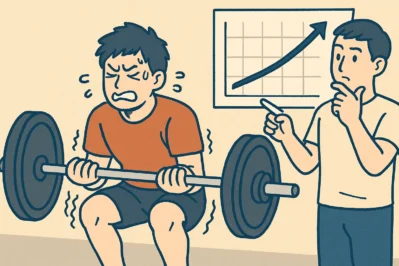Pushing Past the 한계: Is Training to Failure a Fad or Fact in Korea?
Hello! Welcome to Maeil Hangeul (매일한글), your go-to source for leveling up your Korean skills to expert status!
Today, we’re stepping out of the classroom and into the gym. We’ll be tackling a sophisticated topic straight from the world of sports science: the debate around the effectiveness of “training to failure.” This is perfect for when you’re discussing workout philosophies with Korean friends, watching fitness YouTubers, or reading expert articles on health and training.
Lately in Korea, the “Body Profile” (바디 프로필) trend has become a massive cultural phenomenon. It’s not just celebrities; people from all walks of life are documenting their fitness journeys. This has ignited passionate online discussions about the best ways to achieve results, bringing advanced concepts like “training to failure”—or 실패 지점까지 운동하기 (sil-pae ji-jeom-kka-ji un-dong-ha-gi)—into the mainstream. Let’s get into the linguistic workout!
Key Expressions for Your Fitness Debate
Here are some advanced terms that will make you sound like a seasoned pro when discussing training theories.
1. 실패 지점 (Failure Point)
- Pronunciation: [sil-pae ji-jeom]
- English Meaning: Failure point (in training)
- Detailed Explanation: This is a technical term referring to the exact moment in a weight training set where your muscles are so fatigued that you cannot complete another repetition with proper form. It’s a cornerstone concept when discussing training intensity and volume. You’ll often hear it used with verbs like 도달하다 (do-dal-ha-da: to reach) or 가다 (ga-da: to go to). For example, “마지막 세트는 실패 지점까지 가야 해.” (The last set has to go to the failure point.)
2. 점진적 과부하 (Progressive Overload)
- Pronunciation: [jeom-jin-jeok gwa-bu-ha]
- English Meaning: Progressive overload
- Detailed Explanation: This is the fundamental principle of strength training. It means gradually increasing the stress placed upon the body during exercise to continually stimulate new growth. 점진적 (jeom-jin-jeok) means ‘progressive’ or ‘gradual,’ and 과부하 (gwa-bu-ha) means ‘overload.’ This Sino-Korean term is standard in academic papers, expert columns, and serious discussions about long-term fitness programming.
3. ~에 대한 갑론을박이 있다 (There is a heated debate about~)
- Pronunciation: [~e dae-han gam-non-eul-bak-i it-da]
- English Meaning: There is a heated debate about~ / There are arguments for and against~.
- Detailed Explanation: This is a highly sophisticated way to express that a topic is controversial. 갑론을박 (gam-non-eul-bak) is a four-character idiom (사자성어) that literally means “Argument from A, Rebuttal from B.” Using it shows a high command of Korean and is perfect for formal or written contexts where you want to acknowledge differing viewpoints on a complex issue.
4. 효용성 (Utility / Effectiveness)
- Pronunciation: [hyo-yong-seong]
- English Meaning: Utility, usefulness, effectiveness.
- Detailed Explanation: While you might know the word 효과 (hyo-gwa: effect), 효용성 (hyo-yong-seong) carries a more nuanced, academic meaning of ‘the quality of being useful or beneficial.’ It’s used to evaluate the practical value of a method, theory, or policy. Discussing the “효용성” of a training style implies a deeper analysis of its pros, cons, and overall worth.
Example Dialogue: At the Gym
Let’s see how these expressions play out between two friends, Min-jun and Su-jin, at a gym in Seoul.
A (Su-jin): 와, 민준아. 마지막 세트 정말 한계까지 밀어붙이네. 항상 그렇게 실패 지점까지 운동하는 편이야?
(Wa, Min-jun. You’re really pushing to the absolute limit on that last set. Do you always train to the failure point?)
B (Min-jun): 응. 나는 점진적 과부하 원리를 제대로 적용하려면 이게 필수라고 봐. 유명 헬스 유튜버 김계란도 이따금씩 실패 지점 훈련을 강조하잖아.
(Yeah. I believe it’s essential to properly apply the principle of progressive overload. The famous fitness YouTuber ‘Gyeran Kim’ also emphasizes training to failure from time to time.)
A (Su-jin): 일리 있네. 하지만 이 훈련법의 효용성에 대한 갑론을박이 꽤 치열하지 않아? 부상 위험이 크다는 의견도 많던데.
(That makes sense. But isn’t there a pretty fierce debate about the utility of this training method? I’ve seen many opinions that the risk of injury is high.)
B (Min-jun): 맞아. 그래서 전문가들은 운동 목적과 경력에 따라 전략적으로 사용하라고 조언하지. 무조건적인 정답은 없는 셈이야.
(True. That’s why experts advise using it strategically depending on one’s training goals and experience. It means there’s no single correct answer for everyone.)
Culture Tip: The ‘Geun-Seong-Jang’ (근성장) Mindset
In Korea, the term 근성장 (geun-seong-jang), or ‘muscle growth,’ has become a popular metaphor that extends far beyond physical fitness. It now symbolizes personal growth, resilience, and the process of overcoming challenges to become a stronger individual.
You might hear someone talk about their “인생의 근성장” (in-saeng-ui geun-seong-jang), or ‘life’s muscle growth,’ referring to their efforts to improve their career, skills, or character.
This mindset is why the debate over the 실패 지점 (failure point) resonates so deeply. For many, pushing to the point of failure is a philosophical act. It reflects a cultural appreciation for perseverance and enduring hardship (고생 – go-saeng) to achieve a greater future reward. This narrative is everywhere—from K-dramas featuring underdog protagonists to the famously rigorous training schedules of K-pop idols.
So, when you use terms like 점진적 과부하 and 실패 지점, you’re not just discussing exercise; you’re tapping into a core Korean cultural value of diligent, incremental effort leading to profound transformation.
Let’s Practice!
Time to put your knowledge to the test.
- Fill in the blanks with the appropriate words from today’s lesson:
- “많은 전문가들 사이에서 이 훈련법의 _________에 대한 ___________이/가 계속되고 있다.”
- (Among many experts, the heated debate about the ___________ of this training method continues.)
- Your Turn: Think about a personal goal (learning Korean, a new skill, etc.). How can you apply the principle of 점진적 과부하 (progressive overload) to it? Write a short sentence in Korean.
You’ve done an amazing job today tackling these advanced concepts!
What are your thoughts on training to failure? Do you think it’s effective? Leave a comment below using the expressions we learned today! We’d love to hear your opinion.






